The character of West Terrace has changed from a nineteenth century residential street to a traffic thoroughfare lined with car sales outlets. Adelaide’s first weather observatory was located in the parklands on the western side of this terrace. The heritage-listed West Terrace Cemetery still draws visitors and new occupants.
Naming West Terrace
Colonel William Light set out the main streets and terraces of the City of Adelaide in his Plan of 1837. The streets were named by a Street Naming Committee made up of 12 prominent officials in May of that year. The roads marking the boundary of ‘South Adelaide’, as distinct from North Adelaide, were named geographically – East, West, North and South Terraces.
Streets ending at West Terrace south of North Terrace, which becomes Port Road, are: Hindley Street, Currie Street, Waymouth Street, Grote Street, Gouger Street; Wright Street, Sturt Street and Gilbert Street. The western border of the terrace is the West Parklands, comprising Wirrarninthi/Park 23, Tampawardli/Park 24 and Narnungga/Park 25.
Light did not include roads through the West Parklands in his original plan. However, by the 1860s Glover Avenue and Hilton Road (now Sir Donald Bradman Drive) linked the city to nearby villages.
Early European Settlement
Light’s Plan printed in 1840 shows all but two of the ‘town acres’ along the east side of West Terrace were owned; 14 were preliminary purchases made prior to European settlement in 1836 and four were auctioned. Financier and South Australian Colonisation Commissioner John Wright (after whom Wright Street is named) held town acres 187 and 252, between Waymouth Street and Franklin Street.
Two years later, Kingston’s map reveals the beginnings of settlement. The Emigrant Location (or Emigration Square) where arrivals camped in tents and makeshift huts was operating in the parklands opposite the end of Currie Street. A signal station had been erected nearby. While two of the acres had been subdivided, few of the acres had any construction on them. Buildings made of wood, pise (lath and plaster) or stone were scattered and small.
However, it was not long before structures reflecting the development of a community were erected along West Terrace. They included a flour mill, two hotels, the Catholic Bishop’s residence and a cemetery.
The West Terrace Mill
Phillips & Horne’s Mill was one of two wind-powered flour mills erected in Adelaide in 1842. Designed by George Strickland Kingston and built by Mr Fuller of Leigh Street, it occupied acre 186 on the northern corner of Waymouth Street. The impressive circular mill tower was constructed of bricks made from River Torrens clay. It had walls 1m thick and more than 15m high, topped by a dome. Woodwork was of imported Baltic timber. Window sills of white stone contrasted with the brickwork. Inside sills and flooring on the ground floor were of Willunga slate.
A steam engine replaced the sails after they were damaged by lightning in 1845. The mill was destroyed by fire in 1876 and demolished some time later. The ruins can be seen in the view of Adelaide shown in the supplement to the Illustrated Sydney News of July 1876.
Hotels: The Newmarket and The Elephant and Castle
The Newmarket Hotel occupies town acre 1 on the corner of West Terrace and North Terrace, close to where Colonel William Light began his survey of the city in January 1837. The first hotel on this site was constructed in 1847 and the first publican was WH Dumbleton. It was named after the livestock market and slaughterhouse that operated opposite on North Terrace until the 1920s. ‘The butcher’, a South Australian beer measure, may have come into use at this hotel. The present hotel was built by W Baker in 1883 for Mrs Frances Barman, who owned the Newmarket from 1876 to 1899. Designed by Daniel Garlick, the rebuilt hotel boasted three floors plus cellarage.
The Elephant and Castle Hotel was built in 1849 towards the southern end of West Terrace on a northern part of acre 622. John Wickham Daw jnr held its first licence for about a year. The hotel was rebuilt on the corner of Gilbert Street on the same acre in 1879.
Both heritage-listed hotels were still operating in 2014.
Bishop’s Palace
In 1844 Adelaide’s first Catholic Bishop, Francis Murphy, together with Reverend Michael Ryan and Richard Counsel, purchased acre 320 on the terrace’s northern corner with Grote Street. A residence was constructed there between 30 March and 19 December of 1845.
The Regency style bow-sided building was designed by George Strickland Kingston, who was also the architect for alterations in 1859. A new porch, window surrounds and the northern wing added in 1882 changed the character of the residence to an Italianate mansion. Further extensions in 1918, 1935 and 1936 expanded the complex but the original structure is still discernible. Heritage-listed Bishop’s Palace (now Archbishop’s House) is one of the earliest Catholic buildings surviving in South Australia.
West Terrace Cemetery
Colonel William Light planned a cemetery in the southwest parklands. Initially named the Adelaide Public Cemetery it became known as the West Terrace Cemetery. An estimated 500 people were interred there before the first recorded burial on 6 July 1840. The cemetery was fenced off from the rest of the parklands in that year.
Reflecting the European tradition of religious denominations managing the burial of their members, sections for particular groups were created: Jewish (1843), Catholic (1845), Anglican (1849) and Quakers (1855). In 1854 a planned approach to burials using a grid pattern was instituted.
West Terrace in the 1860s
By the mid 1860s residents along West Terrace included a merchant, confectioner, clerk, miller, builder and shorthand writer. A weighbridge was operating next door to the first Elephant and Castle Hotel and the first St Patrick’s Catholic Church had been built behind the Bishop’s Palace.
The parklands on the western side of the terrace were largely used for grazing, firewood and agistment of livestock. Most native vegetation had been removed, to be replaced by tree plantings in the cemetery and along the roadways, now including Glover Avenue and Hilton Road. In the late 1860s a white-painted timber post and wire fence separated West Terrace from the parklands.
The Adelaide Observatory
An important addition to West Terrace was the Adelaide Observatory built for the multi-faceted Sir Charles Todd (1826–1910). The pioneer of a network of telegraph lines to connect the colony to the world, Todd was South Australia’s superintendent of telegraphs, government astronomer, postmaster-general and meteorologist.
The Adelaide Observatory complex, including the Todd family residence and weather recording equipment, was located in the West Parklands between the ends of Currie Street and Waymouth Street. The earliest veranda covered section of the main building was completed in May 1860. A tower, with tripartite blind windows and transit room was begun in 1873. The whole complex, including a domed equatorial room, was completed by 1876.
The Adelaide Observatory boasted refracting and transit telescopes, a time service and a seismograph. The equipment enabled Todd to undertake geodetic surveys and observations of comets, planetary satellites and other astronomical phenomena. Experimental wireless telegraphy equipment transmitted between Adelaide and Henley Beach in 1899. The Observatory became the hub for meteorological observation stations that reported daily using the telegraph system. Regular forecasts and maps were published from the data collected.
The Observatory was joined by the Commonwealth Weather Bureau building in 1941. The complex was demolished over some years to 1952 to make way for the Adelaide Boys High School. Much later the weather bureau functions were transferred to a site at Kent Town, an inner suburb of Adelaide.
Residential West Terrace: the 1870s
A decade later, West Terrace was developing into a largely residential street, with emerging smaller side-streets. The views portrayed in the Australasian Sketcher in July 1875 and Illustrated Sydney News a year later show single and two-storeyed dwellings along the eastern side, interspersed with greenery and paddocks. Directories indicate that homes towards the railway lines on North Terrace were occupied by railway workers, a station master, loco superintendent and stoker. Blacksmiths, a traveller, labourers, a mason, storemen, a carter, a builder and a clerk lived in cottages and terraces to South Terrace. One small cottage between Gouger Street and Wright Street, and surrounded by vegetation, was occupied by seedsman John Brown. The Misses Rackstraw ran a school nearby.
Olive trees were planted in the West Parklands in the early 1870s. New fencing and repairs were carried out in 1878–79. The Observatory became a focus of community interest.
A significant addition to the West Terrace Cemetery was the Smyth Memorial Chapel, built in 1871 as a memorial to Father John Smyth (1824–70). The octagonal bluestone building was designed by Edward Woods, who also designed the Adelaide Town Hall and the General Post Office. It was opened by Bishop Laurence Bonaventure Sheil (1815–72) on 22 October 1871.
The heritage-listed chapel is a rare example of a mortuary in an Australian cemetery. It is the focus of the Catholic section and is surrounded by graves of eminent South Australians and members of religious orders. Smyth and Sheil are buried in a crypt beneath the chapel.
West Terrace at the turn of the century
The population along West Terrace grew significantly from the 1880s. The construction of Margaret and Howe Terraces and Sea View Cottages emphasised the persistent residential nature of the terrace. By 1905 more than 80 households lived on West Terrace. One head of a household, FEP Jolly, was a boat proprietor and the owner of Jolly’s Boathouse on the River Torrens. But businesses on the terrace itself were few. Only the Waverley Vinegar Co. and monumental masons operated into the twentieth century, from sites near the Elephant and Castle Hotel.
One residence became noteworthy. On 11 April 1905 a large two-storey house at 31 West Terrace which had been built in 1866 by Henry Robert Fuller (Adelaide’s mayor in 1866–69 and 1882–83) was bought by Mary MacKillop, Mother General and co-founder of the Sisters of St Joseph of the Sacred Heart, South Australia and the Catholic Church Endowment Society. It became St Joseph’s House of Providence offering support and sanctuary to people regardless of circumstances and background.
The house provided temporary accommodation until 1951, when it was relocated to Cowandilla, south of the city. The building was subsequently demolished. In November 2010 a plaque of black marble dedicated to the memory of the sisters for their social welfare work in Australia, especially in the City of Adelaide, and New Zealand was erected on the site which is now occupied by a luxury car firm.
The Twentieth Century
At the beginning of the twentieth century the West Parklands were neglected. The Adelaide City Council continued to dump rubbish there. In 1907 Messrs Bennett and Fisher were permitted to graze between 200 and 600 sheep thus ‘keeping the grass down’. However, by the end of the first decade improvements were being made. At the request of local residents a bandstand and garden reserve were created in 1909 and band concerts commenced. The area was named Kingston Park (later ‘Gardens’) after George Strickland Kingston.
The West Terrace Cemetery was the scene of scandal during this period. On 4 July 1901 Ngarrindjeri man Poltpalingada Booboorowie (‘Tommy Walker’) died. He had lived in the parklands for many years and was a well-known figure in Adelaide. The headstone for his grave at the West Terrace Cemetery was paid for by Adelaide Stock Exchange. In 1903 it was discovered that the state’s coroner, Dr William Ramsay Smith, had removed his skeleton before burial and sent it to the University of Edinburgh, making up the weight in the coffin with sand. Community outrage led to an official inquiry and Smith’s temporary suspension from duty. In the early 1990s the university repatriated Poltpalingada Booboorowie’s remains and he was buried with ceremony at Raukkan Aboriginal Community.
Australia’s first modern crematorium opened at the cemetery in 1903. The Adelaide Crematorium featured an English Gothic-style chapel, furnace room and chimney disguised as an Italianate bell tower. The design by architect A Barham Black was based on the City of London Crematorium. It was built by Isley & Co. On 4 May 1903 Bishin Singh was the first person to be cremated in the facility. The crematorium ceased to operate in 1959 and was demolished 1969: an archaeological investigation of the site was undertaken at the start of the twenty-first century.
The 1920s
In the mid 1920s West Terrace retained its primarily residential character, but it was beginning to change. Boarding houses and apartments now sat between growing numbers of businesses. The Postmaster-General’s Department’s stores and the British Imperial Oil Co. depot had replaced accommodation. GE Morgan & Sons and the monumental works of Maddaford & Polkinghorne and WH Martin were situated at the southern end of the street, together with the Waverly Vinegar Co. and the furniture makers Pengelley & Co.
The council was making improvements across the road, particularly in finally closing the rubbish tips. Recreational facilities were increased in the parklands: tennis courts were added in 1927 and through the decade the council worked at providing amenities for the children of the West End.
Children’s playground
Children from Sturt Street Primary School and Currie Street Observatory School regularly used the West Parklands for recreation from the 1910s in spite of there being no specific provision for them. In October 1918 the council granted 1.2ha in the West Parklands for Adelaide’s first playground. Delays meant that the playground was not to be the first.
Construction commenced in 1920. Fencing, buildings and sewers were complete by 1921. Over the next three years a shelter shed and toilets were added, lawns, hedges and shrubs planted, and play equipment installed. The playground was formally opened by Governor Lieutenant-General Sir Tom Bridges on 10 October 1924. By 1928 the well-equipped facility had a full-time supervisor supplied by the Education Department. The playground was very popular: 3000–5700 children visited the site monthly in the year from October 1927.
The 1940s to 1960s
At the end of the Second World War 80 households resided on the east side of West Terrace. In the West Parklands Aboriginal camps were established as Aboriginal people re-asserted their presence in the city. These continued into the 1960s. Aboriginal children resident in the West End reportedly used the area near the playground as a camp from the 1930s to the 1950s when there was not enough accommodation space in houses.
But by the mid 1960s few homes remained. Industry and motor vehicle sales and service firms dominated the terrace. The first motor vehicle service station of the mid 1940s had been joined by another as well as motor accessory companies. Seven used car dealerships made use of the motor traffic that came in and out of the city via West Terrace. Electrical and appliance industries, engineering firms, land agents, builders, and Johnson & Johnson surgical dressing manufacturers lined the eastern side. Only the monumental works of GE Morgan & Sons and AS Tillett opposite the cemetery reflected past industry.
West Terrace into the twenty–first century
By the 1970s West Terrace had ceased to be a residential street. It was a thoroughfare, where largely small-scale companies relied on through traffic to generate business. By the end of the twentieth century it was down-at-heel. Adelaide’s residential population was low and the thousands living in its outlying suburbs sought cars and other consumer goods nearer to home.
But within a decade the character of West Terrace shifted once again. Its dingy façade began to be transformed by the construction of state-of-the-art venues for upmarket car sales. In 2014 companies along the street were mixed in type and in fortune. The Newmarket Hotel and the Elephant and Castle Hotel still operated and Bishop’s Palace continued to be occupied by the Catholic archbishop.
By the twenty-first century the West Terrace Cemetery had held over 150 000 burials. Documenting the graves of the many South Australians there led to several popular cemetery tours being promoted. In 2009 the Caroline Clark Memorial Garden, commemorating the 50 000 people buried in unmarked graves there, was opened. Caroline Emily Clark was a philanthropist and reformer concerned particularly with destitute children.
Rejuvenating the West Parklands commenced in the new century. Kaurna names were given to particular sections by the Adelaide City Council in consultation with Kaurna people. Art installations were created, indigenous plant species reintroduced, a wetlands was installed, and sport and recreation facilities were upgraded. Meanwhile, debate on the extent of built development on the parklands bordering West Terrace continues and ideas for changing the streetscape have been floated. The location of the new Royal Adelaide Hospital at the northern end of the terrace will bring further change to West Terrace.


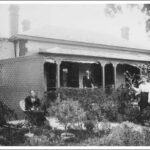

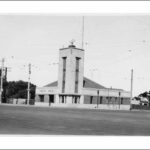
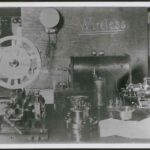
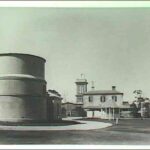
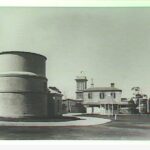
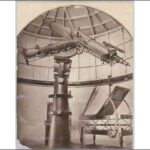
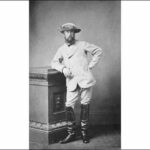
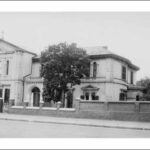
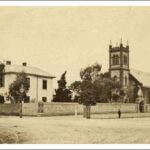
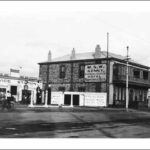
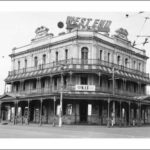
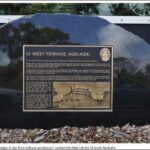
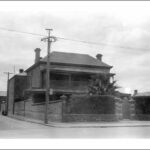
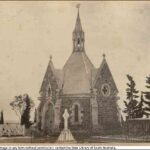
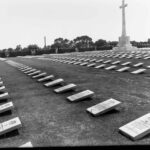
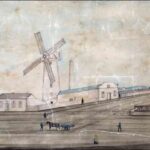

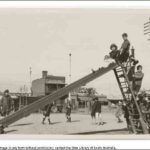
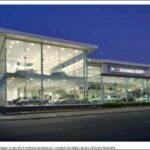
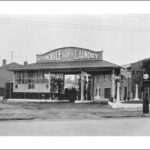

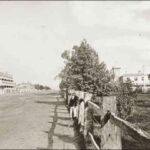
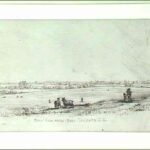
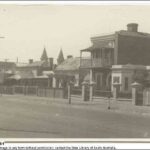


Comments
2 responses to “West Terrace”
does anyone remember in the 1960s a statue/figurine above a shop of what appeared to be a marching girl with a baton. at night she had lights around her. the baton would go up and down. she was on the left hand side of the main road approaching the beach. maybe semaphore
Before my time I’m afraid Elaine, but I’ll let you know if we find out more. If it was Semaphore there might be someone in the City of Port Adelaide Enfield libraries (which include Semaphore library) local history services who can help – https://www.cityofpae.sa.gov.au/page.aspx?u=2357